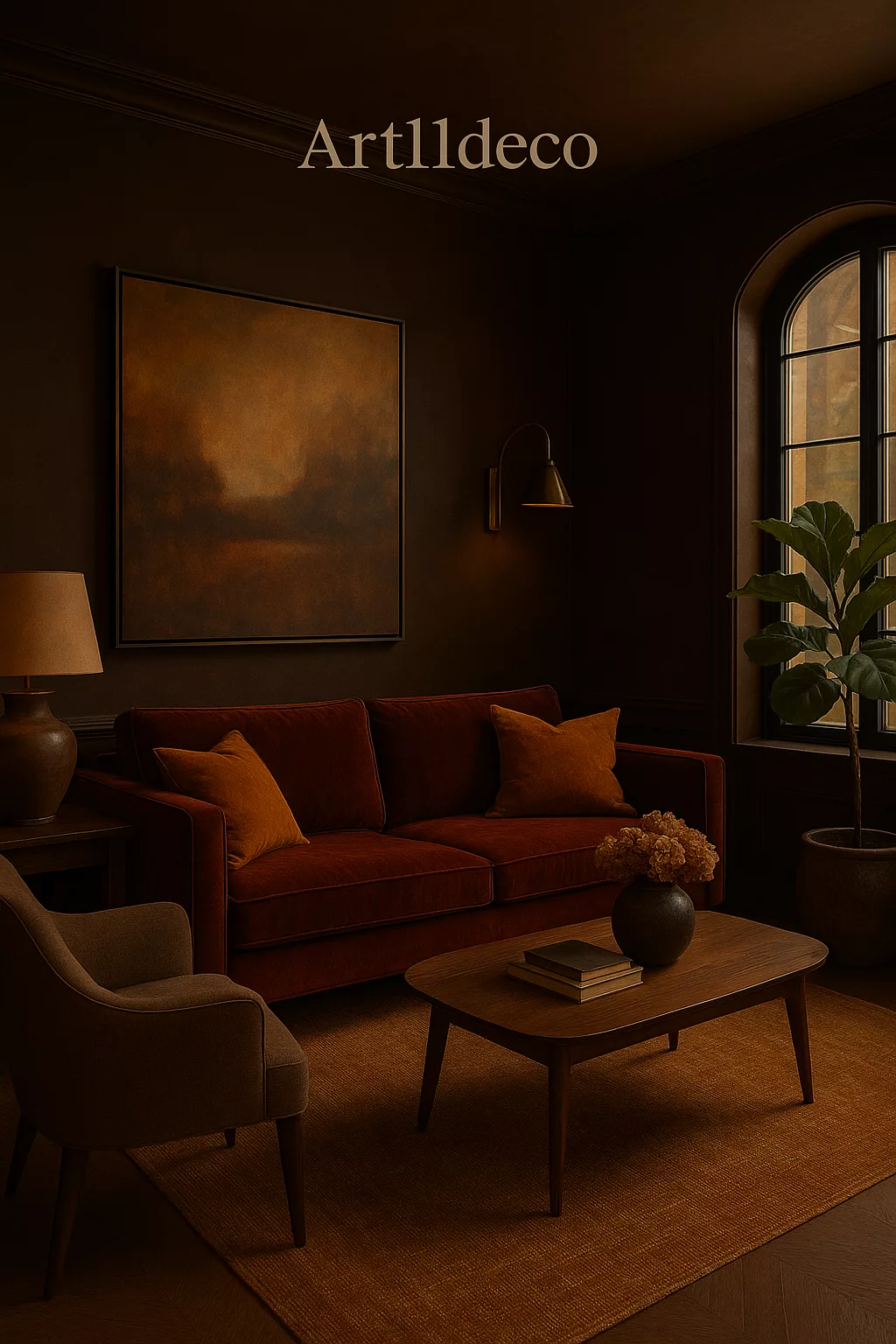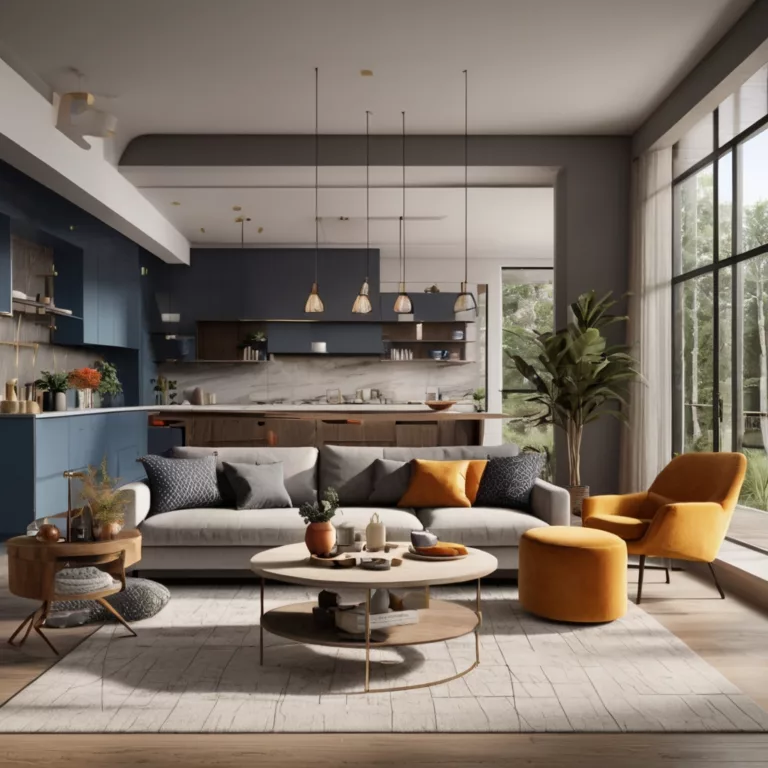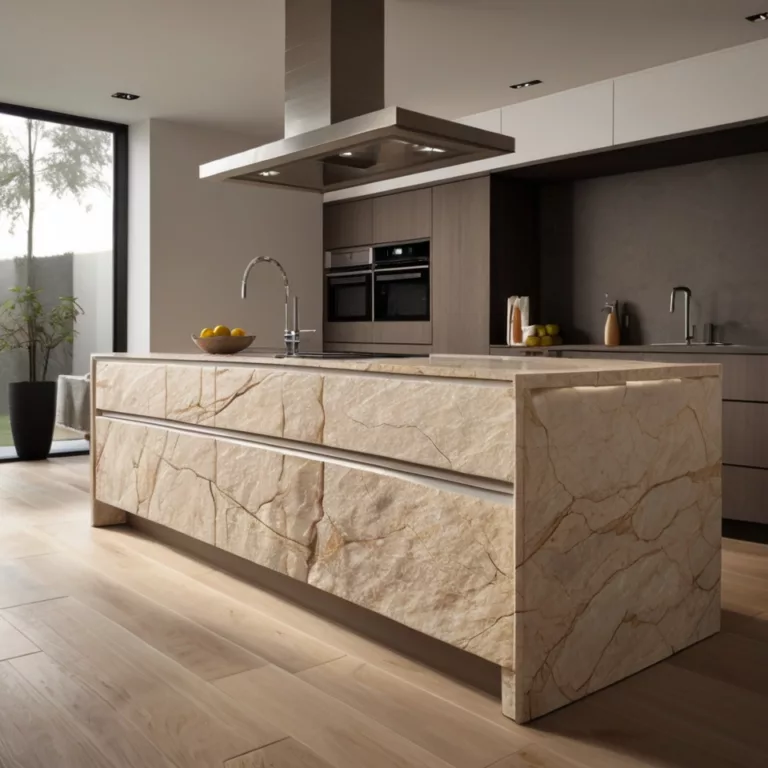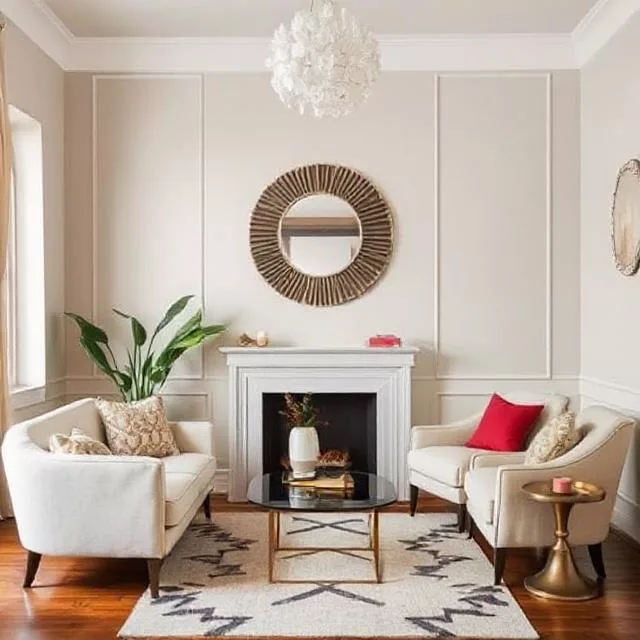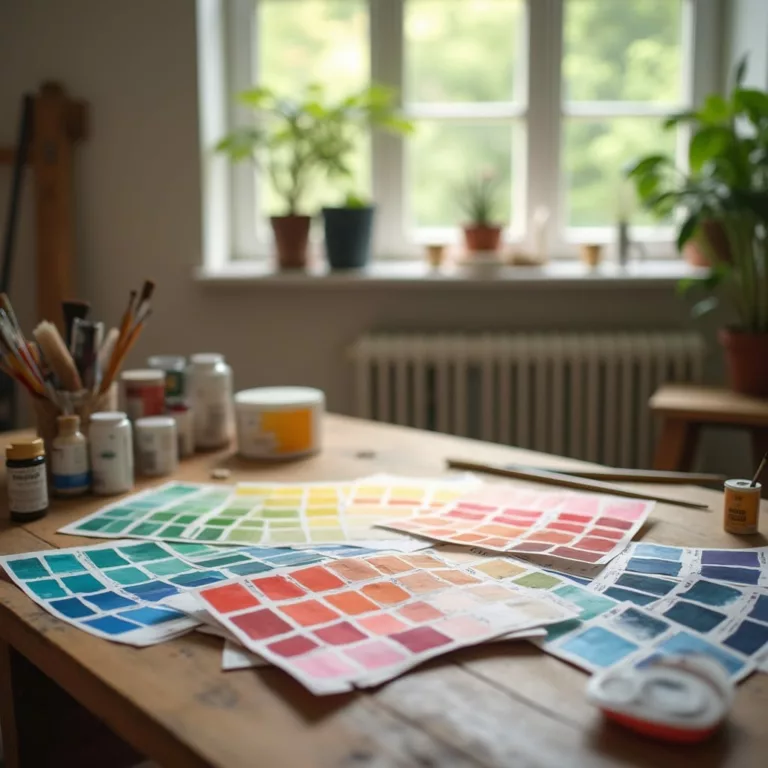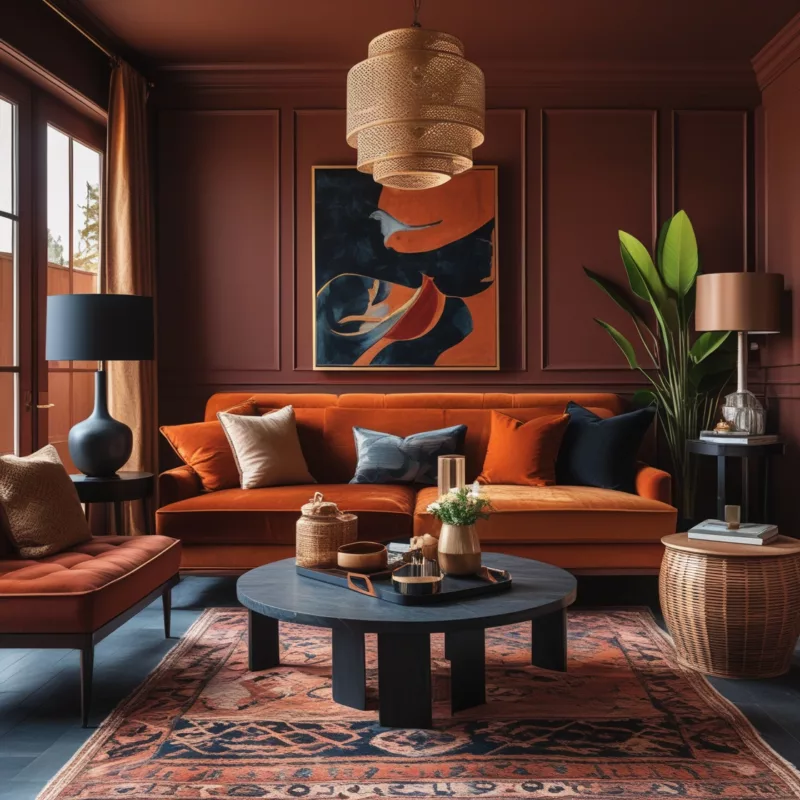
Last Updated: June 2025
Meta Description: Discover how dark warm colors can transform your home into a cozy sanctuary in 2025. Learn expert tips, color combinations, and design strategies for creating inviting spaces with rich, sophisticated hues.
Table of Contents
- Introduction to Dark Warm Colors
- Why Dark Warm Colors Are Trending in 2025
- Psychology Behind Dark Warm Colors
- Top Dark Warm Color Palettes for 2025
- Room-by-Room Dark Warm Color Guide
- How to Balance Dark Warm Colors with Light
- Furniture and Decor That Complements Dark Warm Colors
- Lighting Strategies for Dark Warm Color Schemes
- Common Mistakes to Avoid
- Budget-Friendly Ways to Incorporate Dark Warm Colors
- Seasonal Transitions with Dark Warm Colors
- Professional Designer Tips
- Conclusion
Dark Warm Colors
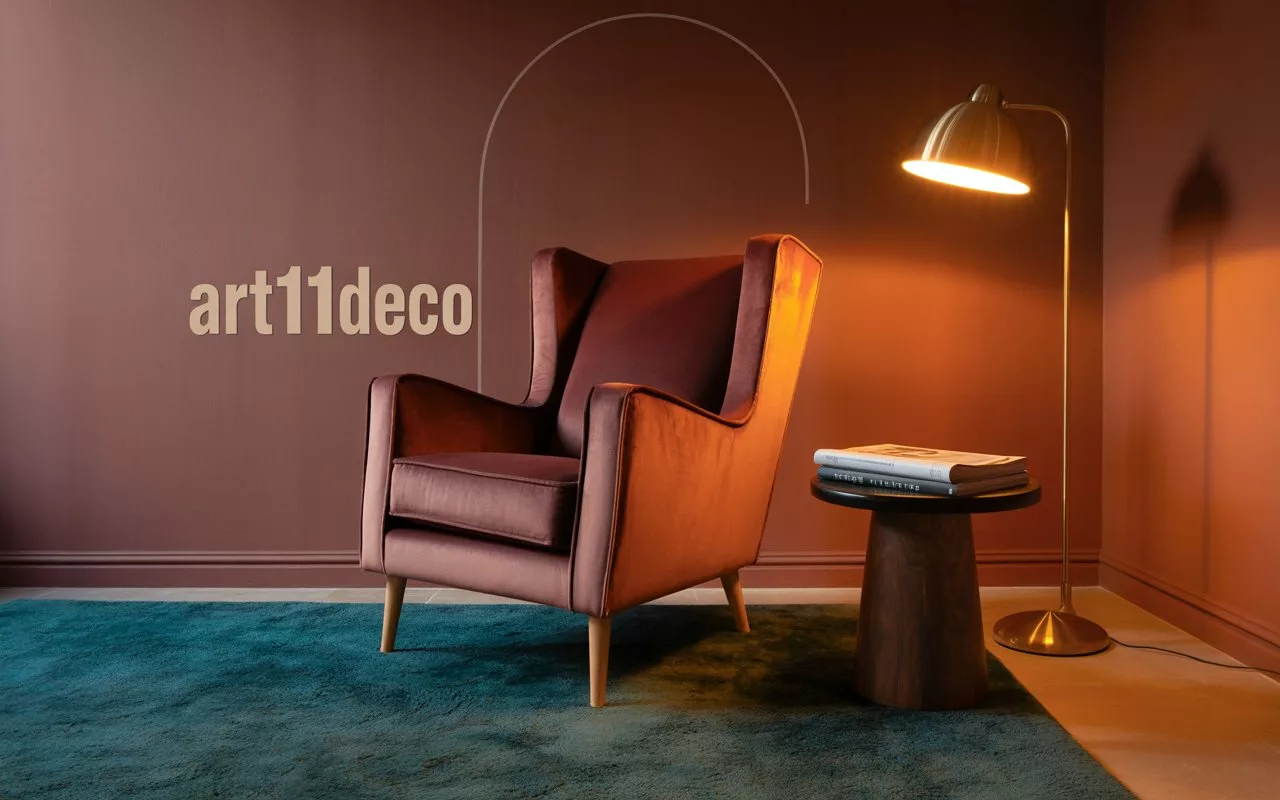
Dark warm colors are revolutionizing interior design in 2025, offering homeowners an opportunity to create spaces that feel both sophisticated and incredibly inviting. These rich, enveloping hues represent a significant departure from the stark minimalism that dominated previous years, embracing instead a philosophy of comfort, intimacy, and emotional connection within our living spaces.
The concept of dark warm colors encompasses a broad spectrum of deep, saturated tones that carry undertones of red, orange, or yellow. These colors create an immediate sense of coziness and can transform any room into a sanctuary that feels like a warm embrace after a long day.
Unlike their cool counterparts, dark warm colors possess an inherent ability to make spaces feel more intimate and welcoming. They work particularly well in creating focal points, adding depth to rooms, and establishing a sense of groundedness that many homeowners crave in our increasingly digital world.
The beauty of dark warm colors lies in their versatility. Whether you’re looking to create a dramatic accent wall, completely transform a living room, or add subtle warmth through accessories, these colors offer endless possibilities for personal expression and style development.
Why Dark Warm Colors Are Trending in 2025
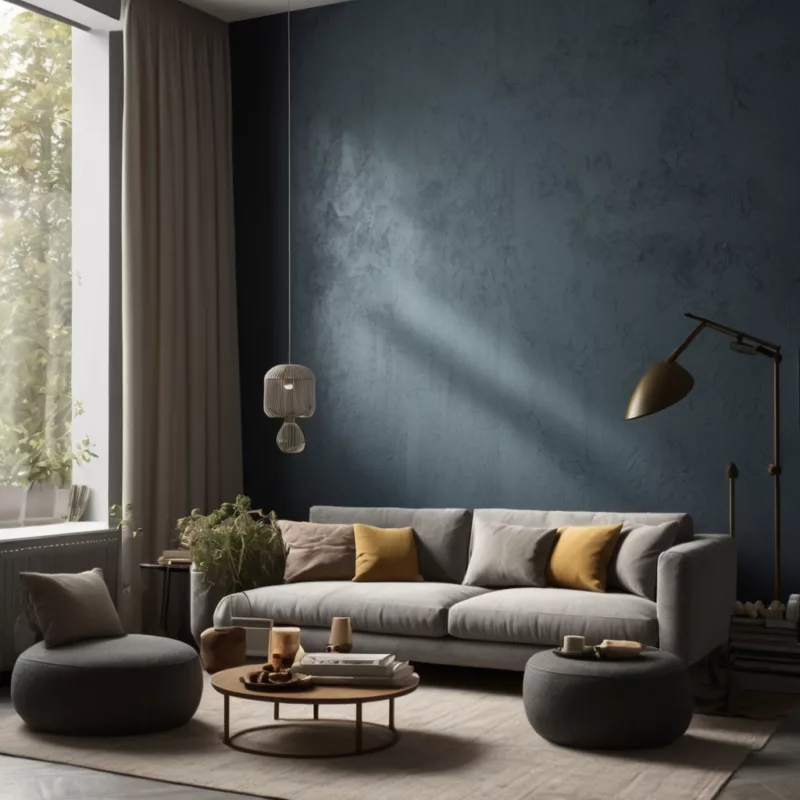
The surge in popularity of dark warm colors reflects broader cultural shifts happening in 2025. After years of uncertainty and change, people are seeking comfort and stability in their homes more than ever before. Dark warm colors provide exactly this sense of security and grounding.
The Cocooning Effect
The concept of “cocooning” has become increasingly important as people spend more time at home. Dark warm colors naturally create enclosed, protective spaces that feel separate from the outside world. This psychological barrier helps establish boundaries between work and rest, public and private life.
Rejection of Cold Minimalism
Many homeowners are moving away from the stark, cold minimalism that characterized the 2010s and early 2020s. Dark warm colors represent a rebellion against sterile environments, instead embracing spaces that feel lived-in, loved, and genuinely comfortable.
Wellness and Mental Health Focus
Dark warm colors have been shown to reduce stress and promote relaxation. As mental health awareness grows, more people are choosing colors that actively contribute to their psychological well-being rather than simply looking aesthetically pleasing.
Social Media Influence
Instagram and Pinterest have showcased countless examples of beautifully designed spaces using dark warm colors. These platforms have democratized interior design knowledge, making sophisticated color choices more accessible to average homeowners.
Sustainability Considerations
Dark warm colors tend to age better than trendy bright colors, making them a more sustainable choice for long-term design. This aligns with growing environmental consciousness among consumers who want to make choices that last.
Psychology Behind Dark Warm Colors
Understanding the psychological impact of dark warm colors is crucial for successful implementation in your home. These colors work on both conscious and subconscious levels to influence mood, behavior, and overall well-being.
Emotional Responses to Dark Warm Colors
Dark warm colors trigger specific emotional responses that can be leveraged for different purposes throughout your home:
Deep Burgundy and Wine: These colors evoke sophistication, luxury, and contemplation. They’re perfect for creating spaces meant for reflection or intimate conversation.
Rich Forest Green: Associated with growth, stability, and connection to nature, forest green promotes feelings of renewal and balance.
Warm Charcoal and Graphite: These near-blacks provide grounding and sophistication while maintaining warmth through their undertones.
Burnt Orange and Terracotta: These earth tones promote creativity, enthusiasm, and social connection, making them ideal for gathering spaces.
Physiological Effects
Research has shown that warm colors can actually increase perceived temperature in a room by 2-3 degrees. This means that dark warm colors can help reduce heating costs while creating a more comfortable environment.
Dark colors also tend to lower heart rate and blood pressure, promoting relaxation and stress reduction. This makes them particularly valuable in bedrooms and other rest areas.
Cultural Associations
Different cultures have varying associations with dark warm colors, but most share common themes of earthiness, stability, and comfort. Understanding these associations can help you choose colors that resonate with your personal background and values.
Top Dark Warm Color Palettes for 2025
Selecting the right dark warm color palette is essential for creating a cohesive and visually appealing space. Here are the most popular and effective combinations for 2025:
The Modern Moody Palette
Primary Colors:
- Deep Plum (#4A2C4A)
- Warm Charcoal (#3C3C3C)
- Cream (#F5F5DC)
Accent Colors:
- Brass Gold (#B5A642)
- Dusty Rose (#C4A484)
This palette works exceptionally well in living rooms and dining areas, creating sophisticated spaces that feel both contemporary and timeless.
The Earthy Sanctuary Palette
Primary Colors:
- Forest Green (#2D4A2B)
- Warm Taupe (#8B7B6B)
- Mushroom Gray (#A0958C)
Accent Colors:
- Copper (#B87333)
- Ivory (#FFFFF0)
Perfect for bedrooms and home offices, this palette connects you to nature while maintaining professional sophistication.
The Cozy Cabin Palette
Primary Colors:
- Burnt Orange (#CC5500)
- Deep Brown (#5C4033)
- Warm White (#F8F8FF)
Accent Colors:
- Golden Yellow (#DAA520)
- Rust Red (#B7410E)
Ideal for family rooms and kitchens, this palette creates an inviting atmosphere that encourages gathering and conversation.
The Sophisticated Drama Palette
Primary Colors:
- Deep Wine (#722F37)
- Charcoal Blue (#2C3E50)
- Warm Gray (#8D8680)
Accent Colors:
- Rose Gold (#E8B4A0)
- Pearl White (#F8F6F0)
This palette works beautifully in master bedrooms and formal dining rooms, creating spaces that feel luxurious and refined.
Room-by-Room Dark Warm Color Guide
Each room in your home serves different purposes and requires thoughtful consideration when implementing dark warm colors. Here’s a comprehensive guide for applying these colors throughout your living space:
Living Room: The Heart of Dark Warm Color Design
The living room offers the greatest opportunity for implementing dark warm colors because it’s typically the largest space and serves multiple functions.
Wall Treatment Options:
- Create a single accent wall in deep burgundy or forest green
- Use a monochromatic approach with varying shades of the same dark warm color
- Implement a two-tone approach with dark warm colors on lower walls and lighter tones above
Furniture Considerations:
Choose furniture in complementary colors that won’t compete with your dark warm walls. Rich leather in cognac or deep brown works beautifully, as does upholstery in cream, warm gray, or muted gold tones.
Lighting Requirements:
Dark warm colors absorb light, so adequate lighting is crucial. Combine ambient lighting with task and accent lighting to create a layered lighting scheme that prevents the space from feeling too dark.
Bedroom: Creating Your Personal Retreat
The bedroom is perhaps the most important room for implementing dark warm colors because of their natural ability to promote relaxation and better sleep.
Color Application Strategies:
- Paint the wall behind your headboard in a deep, warm color to create a focal point
- Use dark warm colors in textiles like bedding, curtains, and rugs
- Consider painting the ceiling in a slightly lighter version of your wall color for a cocooning effect
Balancing Act:
Pair dark warm walls with lighter bedding and furniture to prevent the room from feeling overwhelming. White or cream linens work particularly well against dark warm backgrounds.
Kitchen: Warming Up the Heart of the Home
Kitchens have traditionally been designed in light colors, but dark warm colors can create incredibly inviting cooking and gathering spaces.
Cabinet Considerations:
Dark warm-colored cabinets, particularly in deep green or rich brown, create stunning focal points. Balance these with lighter countertops and backsplashes.
Island Opportunities:
If you’re not ready to commit to dark warm colors throughout your kitchen, consider painting just the island in a rich, warm hue.
Dining Room: Setting the Mood for Memorable Meals
Dining rooms are perfect candidates for dark warm colors because they’re used primarily in the evening when artificial lighting creates a cozy atmosphere.
Full Commitment:
Don’t be afraid to embrace dark warm colors completely in the dining room. Deep wine, forest green, or warm charcoal can create incredibly sophisticated spaces.
Lighting Considerations:
Install a dimmer switch to control the mood and ensure your dark warm colors look their best under various lighting conditions.
Home Office: Productive Comfort
Dark warm colors in home offices can reduce eye strain from computer screens while creating a professional yet comfortable environment.
Focus Wall:
Paint the wall behind your desk in a deep, warm color to create visual interest without being distracting.
Accent Approach:
If a full dark warm color scheme feels too bold for your work space, incorporate these colors through furniture, artwork, and accessories.
Bathroom: Spa-Like Serenity
Bathrooms offer unique opportunities for dark warm colors, particularly in creating spa-like environments.
Powder Room Perfect:
Small powder rooms can handle bold dark warm colors because they’re used for short periods and can benefit from the drama these colors provide.
Master Bath Considerations:
In larger bathrooms, use dark warm colors strategically, perhaps on a single accent wall or in a separate water closet area.
How to Balance Dark Warm Colors with Light {balance-light}
Successfully incorporating dark warm colors requires careful attention to the balance between dark and light elements. This balance prevents spaces from feeling overwhelming while maintaining the cozy, intimate atmosphere these colors provide.
The 60-30-10 Rule Applied to Dark Warm Colors
The classic interior design rule suggests using a dominant color for 60% of the space, a secondary color for 30%, and an accent color for 10%. When working with dark warm colors:
60% – Neutral Base: Use warm neutrals like cream, warm white, or light taupe for the majority of your space. This includes large furniture pieces, major wall areas, and flooring.
30% – Dark Warm Color: Apply your chosen dark warm color to significant but not overwhelming areas like an accent wall, major furniture pieces, or large textile elements.
Strategic Light Placement
Understanding how light interacts with dark warm colors is crucial for successful implementation:
Natural Light Considerations:
Rooms with abundant natural light can handle more extensive use of dark warm colors. South-facing rooms, in particular, provide warm natural light that complements these color choices.
Artificial Light Quality:
Choose warm-toned LED bulbs (2700K-3000K) that enhance rather than fight against your dark warm color choices. Cool-toned lighting can make warm colors appear muddy or unpleasant.
Reflective Surfaces:
Incorporate mirrors, metallic finishes, and glossy surfaces to bounce light around rooms with dark warm colors. This prevents the space from feeling too enclosed or dark.
Texture and Pattern Contrast
Balancing dark warm colors isn’t just about light and dark—it’s also about texture and pattern:
Smooth vs. Textured:
Pair smooth, glossy surfaces in dark warm colors with textured elements in lighter tones. For example, a glossy deep green wall pairs beautifully with a textured cream-colored throw pillow.
Pattern Mixing:
Use patterns to break up solid expanses of dark warm colors. Stripes, geometrics, or florals in lighter colors can provide visual relief and interest.
Furniture and Decor That Complements Dark Warm Colors {#furniture-decor}
Selecting the right furniture and decor is essential for creating cohesive spaces that showcase dark warm colors effectively. The key is choosing pieces that complement rather than compete with your color choices.
Furniture Materials and Finishes
Wood Tones:
- Rich walnut and mahogany complement deep reds and burgundies
- Natural oak and pine work well with forest greens and warm browns
- Reclaimed and weathered woods add texture and authenticity to dark warm color schemes
Metal Finishes:
- Brass and copper enhance the warmth in dark color schemes
- Aged bronze and blackened steel provide sophisticated contrast
- Avoid chrome and bright silver, which can appear cold against warm colors
Upholstery Choices:
- Rich leather in cognac, chestnut, or deep brown
- Velvet in jewel tones or neutral colors
- Linen and cotton in cream, warm white, or soft gold
- Avoid synthetic materials that may clash with the natural feel of dark warm colors
Decorative Accessories
Artwork Selection:
Choose artwork that incorporates your dark warm colors while providing contrast and visual interest. Abstract pieces, landscapes, and photography can all work well when properly selected.
Textile Considerations:
Layer different textures and weights in complementary colors. Wool throws, silk pillows, and cotton curtains in varying shades create depth and visual interest.
Metallic Accents:
Incorporate metallic elements through picture frames, lamp bases, decorative objects, and hardware. Warm metals like brass, copper, and rose gold work particularly well.
Plants and Natural Elements
Living plants provide essential contrast and life to spaces dominated by dark warm colors:
Best Plant Choices:
- Fiddle leaf figs for dramatic height and contrast
- Snake plants for low-maintenance vertical elements
- Pothos and philodendrons for trailing greenery
- Peace lilies for flowering contrast
Natural Material Integration:
- Woven baskets for storage and texture
- Stone and ceramic elements for earthy contrast
- Natural fiber rugs to ground the space
Lighting Strategies for Dark Warm Color Schemes {#lighting-strategies}
Proper lighting is perhaps the most critical element in successfully implementing dark warm colors. Without adequate and appropriate lighting, even the most beautiful dark warm color scheme can appear muddy or unwelcoming.
Layered Lighting Approach
Ambient Lighting:
This is your room’s general lighting that provides overall illumination. For dark warm color schemes:
- Use warm-toned LED bulbs (2700K-3000K)
- Install dimmer switches for mood control
- Consider recessed lighting with warm bulbs for even distribution
Task Lighting:
Focused lighting for specific activities becomes more important with dark colors:
- Table lamps for reading areas
- Under-cabinet lighting in kitchens
- Desk lamps in home offices
- Vanity lighting in bathrooms
Accent Lighting:
This creates visual interest and highlights specific features:
- Wall sconces to highlight artwork or architectural features
- Strip lighting behind furniture or in alcoves
- Candles for soft, romantic lighting
- Picture lights for artwork
Natural Light Optimization
Window Treatments:
Choose window treatments that maximize natural light while complementing your dark warm colors:
- Light-colored curtains or blinds during the day
- Sheer panels that filter light softly
- Roman shades in coordinating warm colors
Reflective Strategies:
- Position mirrors to reflect natural light deeper into rooms
- Use light-colored furniture near windows
- Consider light-colored or reflective flooring near windows
Lighting Design Mistakes to Avoid
Common Errors:
- Using only overhead lighting, which can create harsh shadows
- Choosing cool-toned bulbs that fight against warm colors
- Insufficient lighting levels that make colors appear muddy
- Forgetting to light vertical surfaces, which appear especially dark with dark warm colors
Avoid common-mistakes
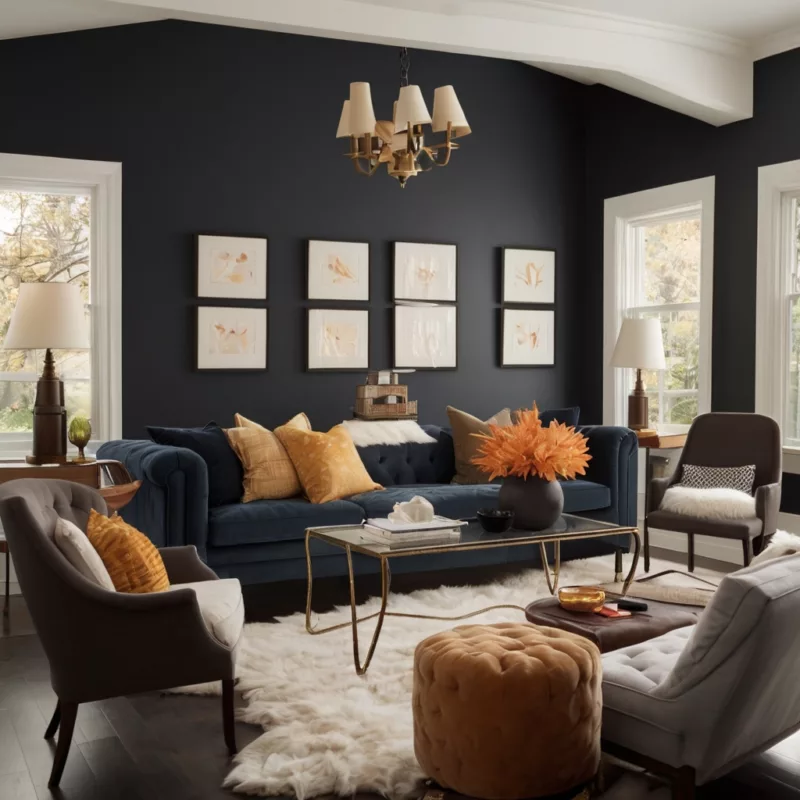
Understanding potential pitfalls can help you successfully implement dark warm colors without regret. Here are the most common mistakes homeowners make and how to avoid them:
Mistake #1: Going Too Dark Too Fast
The Problem:
Many people get excited about dark warm colors and paint entire rooms before testing the colors properly. This can result in overwhelming spaces that feel oppressive rather than cozy.
The Solution:
- Start with accent walls or smaller rooms
- Test paint colors in different lighting conditions
- Live with sample colors for at least a week before committing
- Consider beginning with textiles and accessories before painting walls
Mistake #2: Inadequate Lighting Planning
The Problem:
Dark colors absorb light, and many homeowners don’t adjust their lighting accordingly. This results in spaces that feel dim and unwelcoming.
The Solution:
- Plan your lighting scheme before painting
- Add additional light sources as needed
- Use multiple types of lighting (ambient, task, accent)
- Install dimmer switches for flexibility
Mistake #3: Ignoring Color Undertones
The Problem:
Not all “warm” colors work well together. Mixing colors with different undertones can create muddy or unpleasant combinations.
The Solution:
- Study color undertones carefully
- Test color combinations in your specific lighting
- Stick to colors with similar undertones within a single space
- Consult color wheels and professional resources
Mistake #4: Forgetting About Resale Value
The Problem:
While dark warm colors are trending, they may not appeal to all potential buyers if you decide to sell your home.
The Solution:
- Use dark warm colors in easily changeable ways (paint, textiles)
- Avoid permanent fixtures in very bold colors
- Consider your local market preferences
- Focus on classic dark warm colors rather than trendy variations
Mistake #5: Overwhelming Small Spaces
The Problem:
Using too much dark color in small spaces can make them feel cramped and claustrophobic.
The Solution:
- Use dark warm colors strategically in small spaces
- Balance with plenty of light colors and good lighting
- Consider using dark colors on just one wall or in accessories
- Maximize natural light in small rooms with dark colors
Budget-Friendly Ways to Incorporate Dark Warm Colors {#budget-friendly}
Transforming your home with dark warm colors doesn’t require a complete renovation or massive budget. Here are cost-effective strategies for incorporating these trending colors:
Paint: The Most Impactful Change
Accent Wall Strategy:
Creating a single accent wall in a deep, warm color provides maximum impact for minimal cost. Choose the wall that naturally draws attention, such as the one behind a bed or sofa.
DIY Painting Tips:
- Purchase high-quality paint samples before committing
- Invest in good brushes and rollers for professional-looking results
- Take advantage of paint sales and seasonal promotions
- Consider painting existing furniture for coordinating pieces
Textile Transformations
Pillow Power:
Throw pillows in dark warm colors can instantly transform a neutral sofa or bed. Mix different textures and patterns for added interest.
Curtain Changes:
Swapping out light curtains for ones in deep, warm colors can dramatically change a room’s atmosphere. Look for ready-made options or make your own if you’re handy with a sewing machine.
Rug Replacement:
A new area rug in dark warm tones can anchor a room and provide the color foundation for your design scheme.
Accessory Additions
Artwork and Prints:
Create a gallery wall featuring artwork that incorporates your chosen dark warm colors. Print-on-demand services make custom artwork affordable.
Decorative Objects:
Vases, candles, books, and other decorative objects in dark warm colors can be found affordably at discount stores and online retailers.
Plant Containers:
Repaint existing planters or purchase new ones in dark warm colors to tie your plant collection into your color scheme.
Furniture Updates
Existing Furniture Makeovers:
- Paint wood furniture in deep, warm colors
- Reupholster chair seats with dark warm fabrics
- Add new hardware in complementary finishes
Thrift Store Finds:
Look for solid wood pieces that can be painted or refinished in your chosen colors. With some effort, you can create custom pieces for a fraction of retail cost.
DIY Decor Projects
Wall Treatments:
- Create a faux finish using dark warm colors
- Install board and batten painted in deep colors
- Use removable wallpaper in dark warm patterns
Seasonal Decorations:
Make your dark warm color scheme work year-round by creating seasonal decorations that incorporate these colors in different ways.
Seasonal Transitions with Dark Warm Colors {#seasonal-transitions}
One of the advantages of dark warm colors is their ability to work beautifully across all seasons with minor adjustments. Understanding how to transition your space seasonally while maintaining your dark warm color foundation helps keep your home feeling fresh and current.
Spring Transitions
Adding Fresh Elements:
While maintaining your dark warm color foundation, introduce spring elements:
- Fresh flowers in light colors
- Lighter weight textiles in complementary colors
- Green plants to enhance the natural feeling
- Swap heavy winter throws for lighter cotton or linen versions
Color Adjustments:
- Introduce soft pastels as accent colors
- Use more white and cream elements
- Incorporate fresh green tones through accessories and plants
- Lighten window treatments to maximize natural light
Summer Adaptations
Cooling Strategies:
Make your dark warm colors feel appropriate for warmer weather:
- Remove heavy textiles like wool throws and velvet pillows
- Add cooling elements like linen and cotton in light colors
- Incorporate more metallic accents for light reflection
- Use lighter scents in candles and diffusers
Outdoor Connection:
- Bring outdoor elements inside with natural materials
- Use more glass and transparent elements
- Add water features if possible
- Increase natural light exposure
Fall Enhancement
Embracing the Season:
Fall is when dark warm colors truly shine:
- Add richer textiles in deeper versions of your colors
- Incorporate seasonal elements like pumpkins and autumn leaves
- Use warmer lighting to enhance the cozy feeling
- Add spiced scents through candles and diffusers
Layering Strategy:
- Add additional throw pillows and blankets
- Layer rugs for extra warmth and texture
- Include seasonal artwork and decorations
- Transition to heavier window treatments
Winter Comfort
Maximum Coziness:
Winter is the perfect time to fully embrace dark warm colors:
- Use the richest, deepest versions of your chosen colors
- Add maximum texture through faux fur, wool, and velvet
- Incorporate warm lighting extensively
- Create intimate seating arrangements
Holiday Adaptations:
- Integrate holiday decorations that complement your color scheme
- Use metallic accents for holiday sparkle
- Add seasonal greenery in ways that enhance your existing colors
- Create cozy corners for winter reading and relaxation
Professional Designer Tips
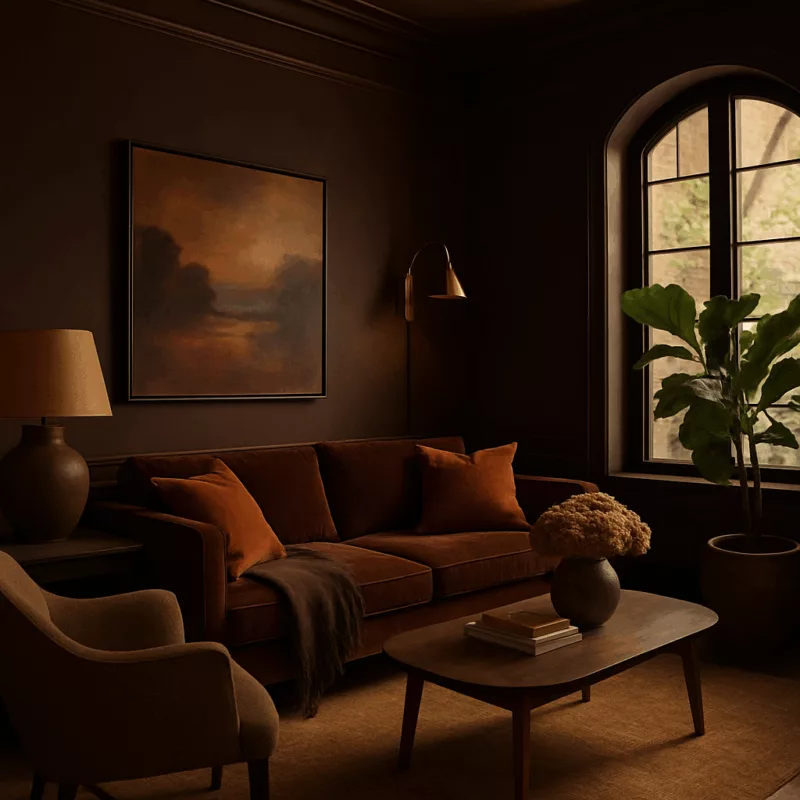
Professional interior designers have developed numerous strategies for successfully implementing dark warm colors. Here are insider tips that can elevate your design:
Color Selection Secrets
The North Light Test:
Always test your dark warm colors in north-facing light, which is the most challenging lighting condition. If colors look good in north light, they’ll look good anywhere.
The 24-Hour Rule:
Live with large paint samples on your walls for at least 24 hours to see how they look in different lighting conditions throughout the day.
Undertone Matching:
When selecting multiple colors, ensure their undertones work together. Hold color samples against each other to check compatibility.
Advanced Design Techniques
Color Gradation:
Use different shades of the same dark warm color throughout a space to create depth and visual interest. Start with the lightest shade on the ceiling and progress to the darkest on accent walls.
Contrast Ratios:
Professional designers use specific contrast ratios to ensure spaces feel balanced. Aim for a 60% light, 30% medium, 10% dark ratio even when using dark warm colors as your main theme.
Texture Layering:
Combine at least three different textures in each room to create visual and tactile interest. This is especially important with dark colors, which can appear flat without texture variation.
Lighting Design Strategies
The Three-Point Lighting System:
Use three different light sources at different heights in each room: ceiling fixtures, table/floor lamps, and accent lighting like sconces or candles.
Color Temperature Consistency:
Keep all light sources within a narrow color temperature range (2700K-3000K) to ensure color accuracy and cohesive lighting.
Shadow Consideration:
Plan lighting to minimize harsh shadows, which are more noticeable against dark backgrounds.
Professional Sourcing Tips
Sample Coordination:
Collect samples of all materials (paint, fabric, flooring) and view them together in your space’s lighting before making final decisions.
Quality Investment:
Invest in higher quality versions of key elements like paint and primary textiles. The difference in color depth and longevity is significant.
Timeline Planning:
Implement dark warm colors gradually, starting with easily changeable elements and moving to more permanent features as you’re sure of your choices.
Conclusion
Dark warm colors represent more than just a design trend—they reflect our collective desire for homes that provide comfort, security, and emotional nourishment in an increasingly complex world. These rich, enveloping hues offer the perfect antidote to sterile, cold spaces, creating environments that truly feel like sanctuaries.
The successful implementation of dark warm colors requires thoughtful planning, attention to lighting, and careful balance with lighter elements. However, when done correctly, these colors can transform any space into a sophisticated, welcoming environment that you’ll love coming home to.
Remember that incorporating dark warm colors is a journey, not a destination. Start small, test thoroughly, and build your confidence as you discover how these beautiful colors can enhance your daily life. Whether you choose to create a single accent wall or embrace dark warm colors throughout your home, you’re participating in a design movement that prioritizes emotional well-being and authentic comfort.
The investment in dark warm colors pays dividends in the form of increased comfort, improved mood, and a home that truly reflects your personality and values. As we move further into 2025, these colors will continue to evolve, but their fundamental appeal—the promise of warmth, comfort, and sanctuary—will remain constant.
By following the strategies outlined in this comprehensive guide, you can confidently transform your home into the cozy sanctuary you’ve always dreamed of, using the power of dark warm colors to create spaces that nurture both body and soul.
Ready to transform your home with dark warm colors? Start with a single accent wall and gradually build your confidence as you discover the transformative power of these sophisticated, comforting hues. Your journey to a more inviting, sanctuary-like home begins with a single brushstroke.
Share your dark warm color transformation on social media using #DarkWarmColors2025 and inspire others to create their own cozy sanctuaries.
Table of Contents – Quick Reference Links
Trusted Sources and References
Color Theory and Psychology Resources
- Pantone Color Institute: Global authority on color trends and forecasting
- International Association of Color Consultants: Professional color expertise and education
- Color Marketing Group: Leading international association for color design professionals
Interior Design Authority Sources
- Architectural Digest: Premier source for luxury interior design inspiration
- Elle Decor: High-end design trends and professional advice
- House Beautiful: Accessible design solutions and expert tips
- Veranda Magazine: Classic and timeless interior design approaches
Lighting and Technical Resources
- Illuminating Engineering Society (IES): Technical lighting standards and best practices
- American Lighting Association: Consumer education and professional lighting guidance
- Lighting Research Center: Scientific research on lighting and human factors
Paint and Color Manufacturers
- Benjamin Moore: Premium paint manufacturer with extensive color research
- Sherwin-Williams: Professional-grade paints and color matching services
- Farrow & Ball: Luxury paint brand known for rich, complex colors
- Clare Paint: Direct-to-consumer paint brand with curated color collections
Home Improvement and DIY Resources
- HGTV: Television network and website focused on home improvement
- Better Homes & Gardens: Lifestyle magazine with practical home design advice
- This Old House: Trusted source for home renovation and improvement projects
- Bob Vila: Expert advice on home improvement and maintenance
Professional Design Organizations
- American Society of Interior Designers (ASID): Professional interior design association
- International Interior Design Association (IIDA): Global community of design professionals
- National Association of Home Builders (NAHB): Industry standards and best practices
Disclaimer: This article provides general design guidance. For specific projects, consult with professional interior designers or contractors. Color perception can vary based on individual factors and environmental conditions.

